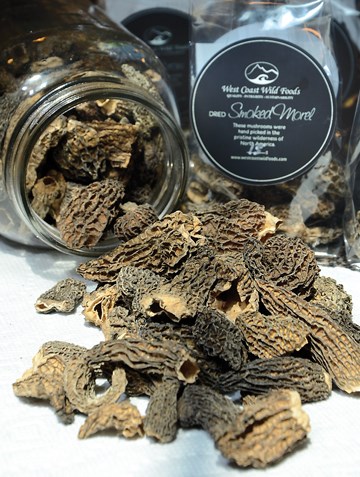Jeremy Budd seems eager to talk about mushrooms
It's not surprising considering he grew up on the Sunshine Coast hunting pine mushrooms with his father.
It was something his father caught on to in the early '80s, and it became a niche industry that was very lucrative for those who could find the precious fungus.
"It was kind of our version of truffle hunting," recalls Budd, who went on to work in the commercial harvesting industry by the time he was 20.
It was there that he met Austin Glenn. The pair became friends over the years flying in to remote locations with planes and helicopters to harvest mushrooms from the bush.
After years of experience working for others, they started their own company in 2009 called West Coast Wild Foods, which just opened a location at Lonsdale Quay in March. The store carries only wild foods. Budd describes "wild" foods as those that are from the natural environment, the mountain and the forests, with no cultivation.
"Wild foods that grow in our forest naturally, so they don't need any help, they don't need any cultivation or anything at all and every product we do is from the natural environment," he says.
The store specializes in wild mushrooms, including morels, and Budd says a lot of people don't realize just how rich B.C. is with different varieties of wild mushrooms.
Talking to the North Shore News from his store recently, Budd is just back from the Yukon where he spent weeks with Glenn scoping out their newest morel harvesting sites. Every year they head up north to set up for their morel season, which includes looking for areas that could potentially have mushrooms later this summer.
Budd explains that morels are unique because they grow in areas that were burned by forest fire the year before.
"They're kind of a special case," he says.
Although they grow naturally all over the province, they grow in abundance only after an area has been burned by forest fire, and northern Canada has a lot of natural forest fires, says Budd.
"When an area is burned it clears out all of the foliage and the plants and everything from the landscape," he explains. "When the fire comes through it will burn the top layer of organic soil off the area and it becomes this very fertile, mineral-rich soil with no other plant life there."
This allows the morel to really flourish and there are enough for them to have a commercial harvest.
Budd and Glenn have developed their own mobile system for drying the mushrooms in the remote locations. The driers use wood heat and air rather than diesel, propane or other sources that can create emissions.
"Over the years we sort of found this system that works for drying them for preservation and quality and keeping the flavour and the integrity and the appearance in the mushroom," says Budd.
They use harvesters from all over the country to bring in their mushroom crop, and sometimes up to 100 or more people can be working in one area. Most of what they harvest is shipped to Europe, and the rest is brought to the store.
Early summer to late spring will bring the conica morel first with its reddish-brown hue. Later in the season "the greys" will come, which are morels in a light grey, almost blond, to dark grey colour.
The store also features edible wild flower products and B.C. maple syrup. But it is the mushrooms that are the subject of discussion at this time of the year.
"These mushrooms are sought after around the world for their flavour and they're used by the top chefs in the world," says Budd about morels.
"When they're fresh you just slice them up and sauté them and add them to your sauces or make them a feature on the plate."
This story originally appeared in the North Shore News special section called Dish, which focuses on food-related stories.



